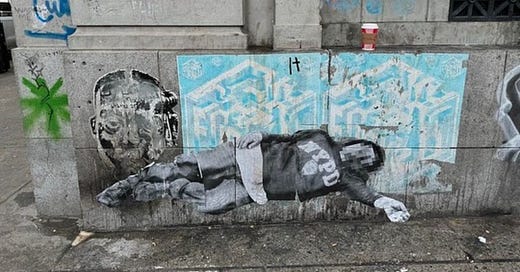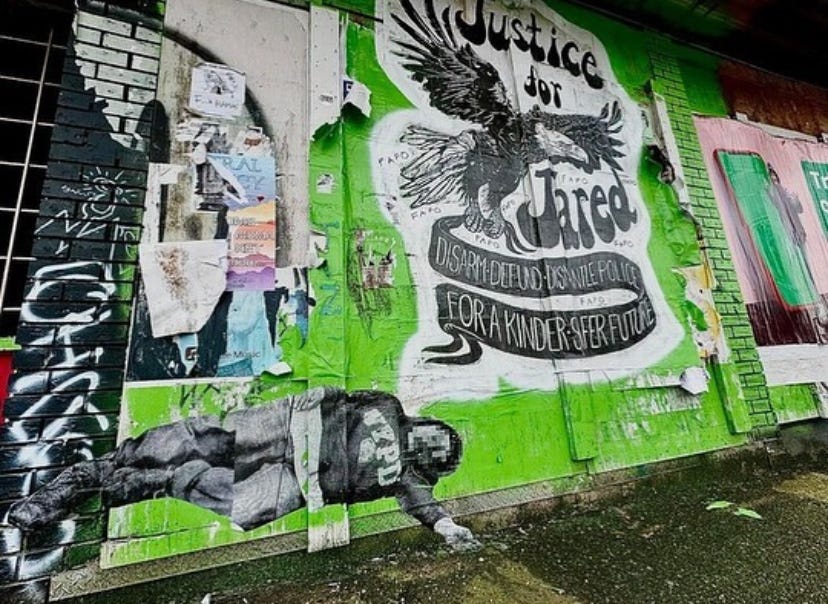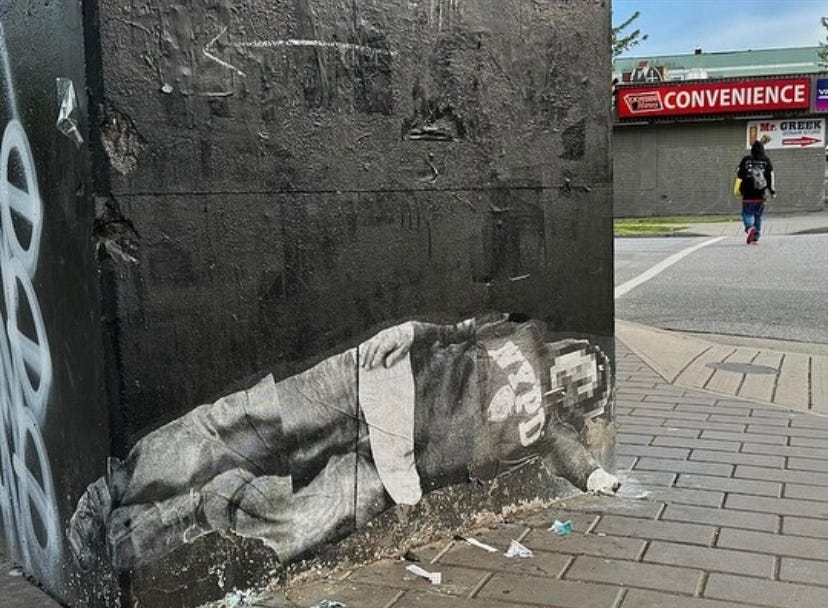Dodo_Urbain (or Urban Naps, in English) is a Montreal-based artist. Their wheat pastes depict a figure, wearing an NYPD hoodie, sprawled out on the ground.
The artist brought their work and perspective to Vancouver’s streets earlier this summer. The work itself is a critique of urban public space and asks the question, who really owns public space. We chatted about art as a protest and their vision for making public spaces more public.
What’s the significance of this image?
The source of the project itself is based on a photograph that I captured of one of my houseless neighbours back in 2018. It just so happened that he was wearing an NYPD hoodie which I thought was pretty ironic. The picture was then blown up in ratio to a life-size figure and the face was then pixelated for the sake of anonymity. The image has no other significance other than the truth it presents.
The pasted life-size figure of the anonymous person sleeping requires the viewer to bear witness and question the presence of whom would usually fade into the background. Every spot that I choose to paste is a response and testimonial of the presence of our unhoused neighbours and their part of our urban landscape.
The site-specific street pasting project, Dodo_Urbain (Urban Naps), seeks to deconstruct the illusion of neutrality in public places to reveal the dehumanization and misery that maintains them. Although the pasting will inevitably be painted over or ripped off, we can no longer hide the truth of the fleeting presence of our houseless neighbours living among us but treated as ghosts.
How did you get started making public art and what materials and processes do you use in your practice?
I started doing graffiti and street art as I was drawn to having my creativity expressed in public spaces rather than the “white cube” gallery space. The objective was to reach a wider audience as opposed to the niche context of institutions like an art gallery or museum. I think it’s also important to distinguish street art and graffiti from public art. Although both are accessible to the public, one is actualized in spontaneous freedom while the other is commissioned and created by municipal order.
The project was first conceptualized in 2021. I asked myself how I could leverage my artistic practice to highlight the ongoing struggles of marginalized populations and the increasing issue of homelessness in our city's landscapes. Dodo_Urbain (Urban Naps) is a direct response to the social issue and seeks to disrupt normative processes.
The pasted figure is made up of three assembled screen prints done on a thin cheap roll of standard printing paper. (The thinner the better as the paper will dissolve into the glue when it dries.) I then cut up several prints and stick them out in the streets with wheat paste that I usually fortify with Mod Podge or any water-based glue in hand for extra tear-proof
How was Vancouver different than where you’re from in terms of public space and art?
Homelessness is everywhere but it was essential for me to come prepared to paste during my time on the West Coast as I’ve noticed from previous visits how drastic homelessness and urban gentrification has gotten.
In comparison to Montreal, I’d say there is a little less street art in Vancouver, but I did notice that the graffiti game is pretty flourishing. Especially East Van!
You say that public space does not exist and that these spaces are often very commercialized and hierarchical. Do you feel it’s possible to force spaces to be more public through art, or is this simply a protest?
“Creativity is the greatest rebellion in existence” Osho. Yes, Dodo_Urbain (Urban Naps) is a form of protest.
Regarding the manifesto, what we call “public space” is actually more of an administrative space, regulated and monitored by municipal and state authorities. Is the space actually public if it is segmented and controlled?
For example, I’m sure many of you have noticed those park benches with the bars going across the middle. Disguised as arms rests, these are really forms of “hostile architecture” made specifically to prevent anyone from laying down. At first glance, you probably wouldn't even notice this “seamless” design that, in reality, is inherently violent by fostering social exclusion.
The space street art and graffiti take up, reveals to us the illusion of neutrality in public places. For example, you would probably only glance quickly at an advertisement billboard for we have become so accustomed to seeing them around us. If someone were to tag on top of that very same billboard, most would probably give it much more attention, (whether they like it or not (LOL!)) as the style of the tag clashes with the ad. I believe the act of practicing street art and graffiti holds the power of desaturating our contemporary urban cities that have been flooded with countless advertisements, so much, that we barely even perceive their cognitive effects on us anymore. It's as though the juxtaposition of the nature of the two within the same space reveals its non-neutrality.
What does your utopian vision of public city spaces look like?
I think the ultimate goal would be for public space to foster accessibility and integration rather than social exclusion. I think the quality of life for all would improve if urban planning was configured around notions of cultivating harmony, connection, and beauty within our common spaces. Institutional religious domination aside, architecture, urban planning and design used to aspire to create spaces that incarnate the beauty of “God”. Now it is often only a question of respecting a budget.
In regards to creating spaces in the notion of beauty, it's also important to note these aesthetic choices do not solely lie in cosmetic appearance, but really facilitate utility to the people who encounter them. It would also be essential to always incorporate nature as we are a part of it and being in its presence has been proven to calm down our nervous systems.
Public transportation would be free. Bartering would be legal and encouraged amongst people within shared spaces. There would also be much more free space as private property would be abolished (except for the retention of personal property). The point of abolishing private property is to also dismantle the hierarchical capitalist conceptions of individualism that created them. In order to support social ownership and distribution of resources, goods, items, and services would be collectively owned. Wealth would be perceived and favoured as a common product of current and preceding generations ensuring that every single person's needs are met as it is in the collective humanity's interest to do so.
What work would you create with unlimited resources?
Not to sound like a pageant princess (LOL), but if I had unlimited resources I would end war, world hunger & homelessness so that I wouldn't even have to use my creativity for a project like Dodo_Urbain (Urban Naps) in the first place. As an artist, I'm not really interested in newness or realism but I am rather drawn to repurposing the discarded.







